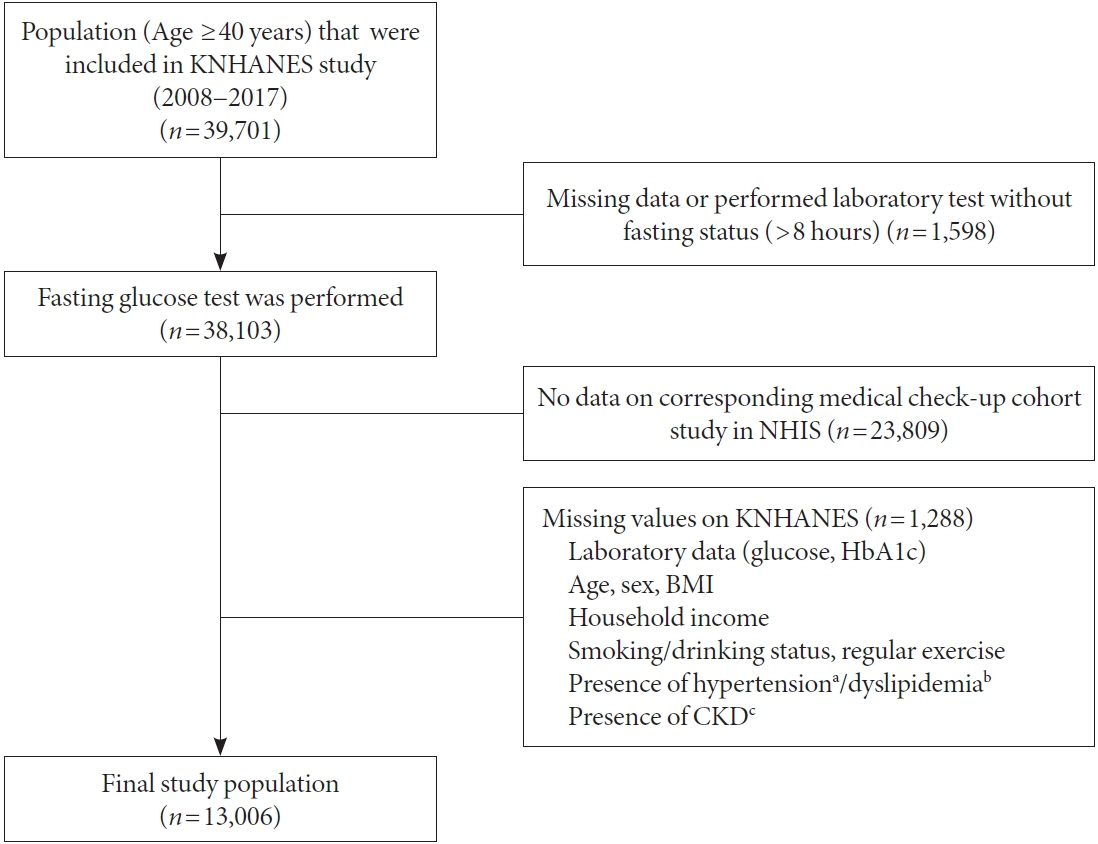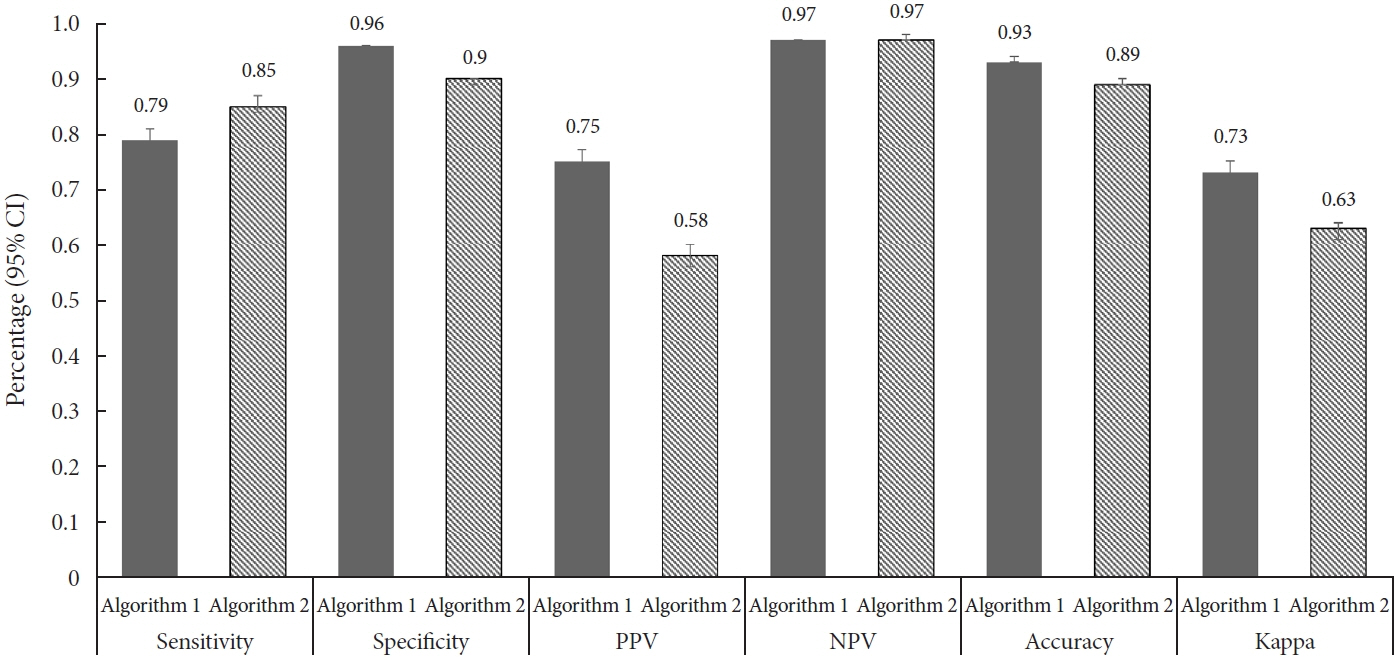Diabetes Metab J.
2023 Mar;47(2):201-210. 10.4093/dmj.2022.0375.
Comparison of Operational Definition of Type 2 Diabetes Mellitus Based on Data from Korean National Health Insurance Service and Korea National Health and Nutrition Examination Survey
- Affiliations
-
- 1Department of Internal Medicine, Gyeongsang National University Changwon Hospital, Gyeongsang National University College of Medicine, Changwon, Korea
- 2Institute of Health Science, Gyeongsang National University, Jinju, Korea
- 3Department of Epidemiology, Fay W. Boozman College of Public Health, University of Arkansas for Medical Sciences, Little Rock, AR, USA
- 4Winthrop P. Rockefeller Cancer Institute, University of Arkansas for Medical Sciences, Little Rock, AR, USA
- 5Department of Statistics and Actuarial Science, Soongsil University, Seoul, Korea
- 6Department of Internal Medicine, Seoul Metropolitan Government Seoul National University Boramae Medical Center, Seoul National University College of Medicine, Seoul, Korea
- 7Division of Endocrinology and Metabolism, Konkuk University Medical Center, Konkuk University School of Medicine, Seoul, Korea
- 8Division of Endocrinology and Metabolism, Department of Internal Medicine, St. Vincent’s Hospital, College of Medicine, The Catholic University of Korea, Suwon, Korea
- KMID: 2540517
- DOI: http://doi.org/10.4093/dmj.2022.0375
Abstract
- Background
We evaluated the validity and reliability of the operational definition of type 2 diabetes mellitus (T2DM) based on the Korean National Health Insurance Service (NHIS) database.
Methods
Adult subjects (≥40 years old) included in the Korea National Health and Nutrition Examination Survey (KNHANES) from 2008 to 2017 were merged with those from the NHIS health check-up database, producing a cross-sectional dataset. We evaluated the sensitivity, specificity, accuracy, and agreement of the NHIS criteria for defining T2DM by comparing them with the KNHANES criteria as a standard reference.
Results
In the study population (n=13,006), two algorithms were devised to determine from the NHIS dataset whether the diagnostic claim codes for T2DM were accompanied by prescription codes for anti-diabetic drugs (algorithm 1) or not (algorithm 2). Using these algorithms, the prevalence of T2DM was 14.9% (n=1,942; algorithm 1) and 20.8% (n=2,707; algorithm 2). Good reliability in defining T2DM was observed for both algorithms (Kappa index, 0.73 [algorithm 1], 0.63 [algorithm 2]). However, the accuracy (0.93 vs. 0.89) and specificity (0.96 vs. 0.90) tended to be higher for algorithm 1 than for algorithm 2. The validity (accuracy, ranging from 0.91 to 0.95) and reliability (Kappa index, ranging from 0.68 to 0.78) of defining T2DM by NHIS criteria were independent of age, sex, socioeconomic status, and accompanied hypertension or dyslipidemia.
Conclusion
The operational definition of T2DM based on population-based NHIS claims data, including diagnostic codes and prescription codes, could be a valid tool to identify individuals with T2DM in the Korean population.
Figure
Cited by 2 articles
-
Risk of Cause-Specific Mortality across Glucose Spectrum in Elderly People: A Nationwide Population-Based Cohort Study
Joonyub Lee, Hun-Sung Kim, Kee-Ho Song, Soon Jib Yoo, Kyungdo Han, Seung-Hwan Lee
Endocrinol Metab. 2023;38(5):525-537. doi: 10.3803/EnM.2023.1765.Big Data Research for Diabetes-Related Diseases Using the Korean National Health Information Database
Kyung-Soo Kim, Bongseong Kim, Kyungdo Han
Diabetes Metab J. 2025;49(1):13-21. doi: 10.4093/dmj.2024.0780.
Reference
-
1. Cascini S, Agabiti N, Davoli M, Uccioli L, Meloni M, Giurato L, et al. Survival and factors predicting mortality after major and minor lower-extremity amputations among patients with diabetes: a population-based study using health information systems. BMJ Open Diabetes Res Care. 2020; 8:e001355.2. Choi Y, Choi JW. Association of sleep disturbance with risk of cardiovascular disease and all-cause mortality in patients with new-onset type 2 diabetes: data from the Korean NHISHEALS. Cardiovasc Diabetol. 2020; 19:61.3. Jung I, Kwon H, Park SE, Han KD, Park YG, Kim YH, et al. Increased risk of cardiovascular disease and mortality in patients with diabetes and coexisting depression: a nationwide population-based cohort study. Diabetes Metab J. 2021; 45:379–89.4. Kim MK, Han K, Lee SH. Current trends of big data research using the Korean National Health Information Database. Diabetes Metab J. 2022; 46:552–63.5. Ko SH, Han K, Lee YH, Noh J, Park CY, Kim DJ, et al. Past and current status of adult type 2 diabetes mellitus management in Korea: a National Health Insurance Service Database Analysis. Diabetes Metab J. 2018; 42:93–100.6. Jagannathan R, Neves JS, Dorcely B, Chung ST, Tamura K, Rhee M, et al. The oral glucose tolerance test: 100 years later. Diabetes Metab Syndr Obes. 2020; 13:3787–805.7. Lee YH, Han K, Ko SH, Ko KS, Lee KU; Taskforce Team of Diabetes Fact Sheet of the Korean Diabetes Association. Data analytic process of a nationwide population-based study using National Health Information Database established by National Health Insurance Service. Diabetes Metab J. 2016; 40:79–82.8. Jo SH, Nam H, Lee J, Park S, Lee J, Kyoung DS. Fenofibrate use is associated with lower mortality and fewer cardiovascular events in patients with diabetes: results of 10,114 patients from the Korean National Health Insurance Service Cohort. Diabetes Care. 2021; 44:1868–76.9. Jeong JS, Kim JS, Yeom SW, Lee MG, You YS, Lee YC. Prevalence and comorbidities of bronchiolitis in adults: a population-based study in South Korea. Medicine (Baltimore). 2022; 101:e29551.10. Kim J, Yang PS, Park BE, Kang TS, Lim SH, Cho S, et al. Association of proteinuria and incident atrial fibrillation in patients with diabetes mellitus: a population-based senior cohort study. Sci Rep. 2021; 11:17013.11. Hong JS, Kang HC. Body mass index and all-cause mortality in patients with newly diagnosed type 2 diabetes mellitus in South Korea: a retrospective cohort study. BMJ Open. 2022; 12:e048784.12. Kim JE, Choi J, Park J, Shin A, Choi NK, Choi JY. Effects of menopausal hormone therapy on cardiovascular diseases and type 2 diabetes in middle-aged postmenopausal women: analysis of the Korea National Health Insurance Service Database. Menopause. 2021; 28:1225–32.13. Lee CJ, Hwang J, Lee YH, Oh J, Lee SH, Kang SM, et al. Blood pressure level associated with lowest cardiovascular event in hypertensive diabetic patients. J Hypertens. 2018; 36:2434–43.14. Lee SE, Kim KA, Son KJ, Song SO, Park KH, Park SH, et al. Trends and risk factors in severe hypoglycemia among individuals with type 2 diabetes in Korea. Diabetes Res Clin Pract. 2021; 178:108946.15. Bae JH, Han KD, Ko SH, Yang YS, Choi JH, Choi KM, et al. Diabetes fact sheet in Korea 2021. Diabetes Metab J. 2022; 46:417–26.16. Kim J, Bae YJ, Lee JW, Kim YS, Kim Y, You HS, et al. Metformin use in cancer survivors with diabetes reduces all-cause mortality, based on the Korean National Health Insurance Service between 2002 and 2015. Medicine (Baltimore). 2021; 100:e25045.17. Park JH, Ha KH, Kim BY, Lee JH, Kim DJ. Trends in cardiovascular complications and mortality among patients with diabetes in South Korea. Diabetes Metab J. 2021; 45:120–4.18. Khokhar B, Jette N, Metcalfe A, Cunningham CT, Quan H, Kaplan GG, et al. Systematic review of validated case definitions for diabetes in ICD-9-coded and ICD-10-coded data in adult populations. BMJ Open. 2016; 6:e009952.19. Kweon S, Kim Y, Jang MJ, Kim Y, Kim K, Choi S, et al. Data resource profile: the Korea National Health and Nutrition Examination Survey (KNHANES). Int J Epidemiol. 2014; 43:69–77.20. Lee HY, Shin J, Kim GH, Park S, Ihm SH, Kim HC, et al. 2018 Korean Society of Hypertension guidelines for the management of hypertension: part II-diagnosis and treatment of hypertension. Clin Hypertens. 2019; 25:20.21. Rhee EJ, Kim HC, Kim JH, Lee EY, Kim BJ, Kim EM, et al. 2018 Guidelines for the management of dyslipidemia. Korean J Intern Med. 2019; 34:723–71.22. Levin A, Stevens PE. Summary of KDIGO 2012 CKD guideline: behind the scenes, need for guidance, and a framework for moving forward. Kidney Int. 2014; 85:49–61.23. Dufour MC. What is moderate drinking?: defining “drinks” and drinking levels. Alcohol Res Health. 1999; 23:5–14.24. Rosenberg DE, Bull FC, Marshall AL, Sallis JF, Bauman AE. Assessment of sedentary behavior with the International Physical Activity Questionnaire. J Phys Act Health. 2008; 5 Suppl 1:S30–44.25. Simundic AM. Measures of diagnostic accuracy: basic definitions. EJIFCC. 2009; 19:203–11.26. Landis JR, Koch GG. The measurement of observer agreement for categorical data. Biometrics. 1977; 33:159–74.27. Chiu CJ, Huang HM, Lu TH, Wang YW. National health data linkage and the agreement between self-reports and medical records for middle-aged and older adults in Taiwan. BMC Health Serv Res. 2018; 18:917.28. Nishioka Y, Takeshita S, Kubo S, Myojin T, Noda T, Okada S, et al. Appropriate definition of diabetes using an administrative database: a cross-sectional cohort validation study. J Diabetes Investig. 2022; 13:249–55.29. Lipscombe LL, Hwee J, Webster L, Shah BR, Booth GL, Tu K. Identifying diabetes cases from administrative data: a population-based validation study. BMC Health Serv Res. 2018; 18:316.
- Full Text Links
- Actions
-
Cited
- CITED
-
- Close
- Share
- Similar articles
-
- Fundus Examination Rate in Diabetics and the Public Health Factors Associated With Fundus Examination Rate
- Validation of Cancer Diagnosis Based on the National Health Insurance Service Database versus the National Cancer Registry Database in Korea
- Data Analytic Process of a Nationwide Population-Based Study Using National Health Information Database Established by National Health Insurance Service
- Operational Definition of Liver Cancer in Studies Using Data from the National Health Insurance Service: A Systematic Review
- Introducing big data analysis using data from National Health Insurance Service




